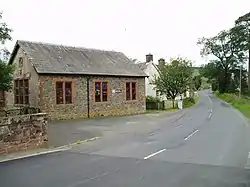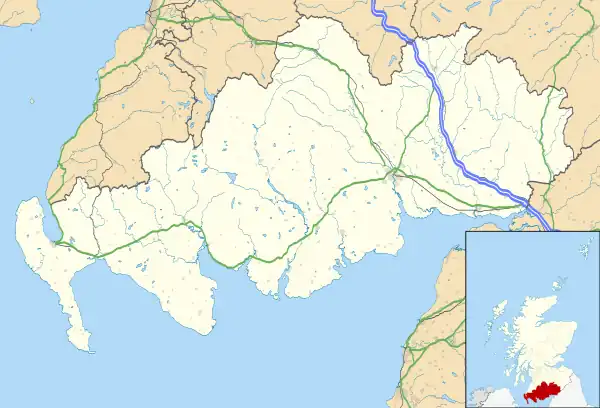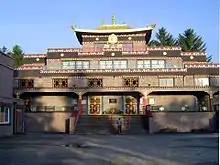| Eskdalemuir | |
|---|---|
 The former primary school, now "The Hub". | |
 Eskdalemuir Location within Dumfries and Galloway | |
| Population | 265 (2001) |
| Civil parish |
|
| Council area | |
| Lieutenancy area | |
| Country | Scotland |
| Sovereign state | United Kingdom |
| Post town | Langholm |
| Postcode district | DG13 |
| Dialling code | 013873 |
| Police | Scotland |
| Fire | Scottish |
| Ambulance | Scottish |
| UK Parliament | |
| Scottish Parliament | |

Eskdalemuir is a civil parish and small village in Dumfries and Galloway, Scotland, with a population of 265.[1] It is around 10 miles (16 km) north-west of Langholm and 10 miles (16 km) north-east of Lockerbie.
The area comprises high wet moorlands, chiefly used for sheep grazing and forestry plantation (Eskdalemuir Forest). The main settlement is near the White Esk river.
Eskdalemuir is probably best known for the Eskdalemuir Observatory and for the Samye Ling Tibetan Buddhist monastery.
Samye Ling Tibetan Buddhist monastery
In the community is the Samye Ling Tibetan Buddhist monastery, which incorporates a former hunting lodge called Johnstone House. Listed as a tourist attraction by VisitScotland.
Archaeology
Eskdalemuir is rich in archaeological remains, including two neolithic stone circles, the Loupin Stanes and the Girdle Stanes, and bank barrow, Castle O'er, a possible ritual centre for the Selgovae, Raeburnfoot, a Roman fort and later dark age fortifications and settlements.
Climate
Due to the establishment of the Eskdalemuir Observatory here in 1908, Eskdalemuir has one of the longest climatological records in the UK, with data stretching back over 100 years. The data shows Eskdalemuir to be a very wet, often cloudy place.
Eskdalemuir holds the UK weather record for the highest rainfall in a 30-minute period: 80 mm (3.1 in), recorded on 26 June 1953.[2] It also holds the record for the dullest summer month; 43.9 hours were recorded in August 1912, and subsequently just 41 hours were measured in August 2008. However, these values are not directly comparable due to a change in recording technique – the earlier having been made using a Campbell–Stokes recorder and the later using an electronic recorder.[3]
Other recent low sunshine records for the site include 30 hours during October 2011,[4] 46 hours during September 2008,[5] and 69 hours during July 2010.[6] Its dullest month was December 2015 with only 9.2 hours recorded. Eskdalemuir experienced its wettest year on record in 2011.[7]
In spite of it being located inland, the dull and wet nature of the climate due to the elevation leads to chilly summers that are colder than more northerly locations such as Glasgow and Edinburgh. The inland nature of the climate is more manifest during winter months with frosts being common, and the average lows between December and February are below the freezing point.[8]
The highest recorded temperature was 32.3 °C (90.1 °F) in July 2022 and the lowest is −19.0 °C (−2.2 °F) in January 2010.
| Climate data for Eskdalemuir (242 m AMSL; averages 1981–2010, extremes 1911–present) | |||||||||||||
|---|---|---|---|---|---|---|---|---|---|---|---|---|---|
| Month | Jan | Feb | Mar | Apr | May | Jun | Jul | Aug | Sep | Oct | Nov | Dec | Year |
| Record high °C (°F) | 11.7 (53.1) |
14.0 (57.2) |
20.1 (68.2) |
23.8 (74.8) |
26.8 (80.2) |
29.9 (85.8) |
32.3 (90.1) |
28.7 (83.7) |
25.0 (77.0) |
22.2 (72.0) |
16.3 (61.3) |
13.4 (56.1) |
32.3 (90.1) |
| Mean daily maximum °C (°F) | 5.0 (41.0) |
5.5 (41.9) |
7.5 (45.5) |
10.4 (50.7) |
13.9 (57.0) |
16.1 (61.0) |
18.2 (64.8) |
17.6 (63.7) |
15.0 (59.0) |
11.4 (52.5) |
7.8 (46.0) |
5.2 (41.4) |
11.1 (52.0) |
| Mean daily minimum °C (°F) | −0.4 (31.3) |
−0.5 (31.1) |
0.7 (33.3) |
2.1 (35.8) |
4.6 (40.3) |
7.6 (45.7) |
9.5 (49.1) |
9.3 (48.7) |
7.2 (45.0) |
4.5 (40.1) |
1.8 (35.2) |
−0.6 (30.9) |
3.8 (38.9) |
| Record low °C (°F) | −19.0 (−2.2) |
−16.6 (2.1) |
−14.7 (5.5) |
−15.4 (4.3) |
−7.1 (19.2) |
−2.5 (27.5) |
−1.7 (28.9) |
−2.2 (28.0) |
−5.0 (23.0) |
−7.8 (18.0) |
−14.3 (6.3) |
−18.5 (−1.3) |
−19.0 (−2.2) |
| Average precipitation mm (inches) | 202.3 (7.96) |
146.5 (5.77) |
154.5 (6.08) |
97.7 (3.85) |
97.5 (3.84) |
98.5 (3.88) |
118.7 (4.67) |
138.4 (5.45) |
135.0 (5.31) |
191.5 (7.54) |
176.5 (6.95) |
184.9 (7.28) |
1,742.1 (68.59) |
| Average precipitation days (≥ 1.0 mm) | 19.7 | 15.0 | 16.8 | 13.7 | 12.5 | 12.9 | 14.0 | 14.9 | 14.9 | 18.3 | 17.6 | 17.1 | 187.4 |
| Mean monthly sunshine hours | 38.0 | 61.2 | 86.4 | 128.3 | 168.4 | 143.7 | 147.8 | 135.7 | 103.1 | 73.1 | 49.8 | 38.8 | 1,174.3 |
| Source 1: Met Office[9][10] | |||||||||||||
| Source 2: WeatherJournal[11] | |||||||||||||
References
- ↑ General Register Office for Scotland : Census 2001 : Usual Resident Population : Eskdalemuir Civil Parish Archived 2012-03-07 at the Wayback Machine Retrieved 2009-11-21
- ↑ Met Office article Archived 29 December 2010 at the Wayback Machine
- ↑ "August sun". climate-uk.
- ↑ "October sun". climate-uk.
- ↑ "September sun". climate-uk.
- ↑ "July sun". climate-uk.
- ↑ "Eskdalemuir rainfall highest on record". BBC News. BBC. 4 January 2012. Retrieved 10 January 2012.
- ↑ "Eskdalemuir 1981-2010 Climate Averages". Met Office. Retrieved 18 April 2016.
- ↑ "Eskdalemuir Climate". UKMO. Retrieved 18 April 2016.
- ↑ Office, Met. "Eskdalemuir climate". www.metoffice.gov.uk.
- ↑ Dawson, I. K. (2005). "Eskdalemuir extremes". Weather. 60 (3): 66–69. doi:10.1256/wea.218.03.
